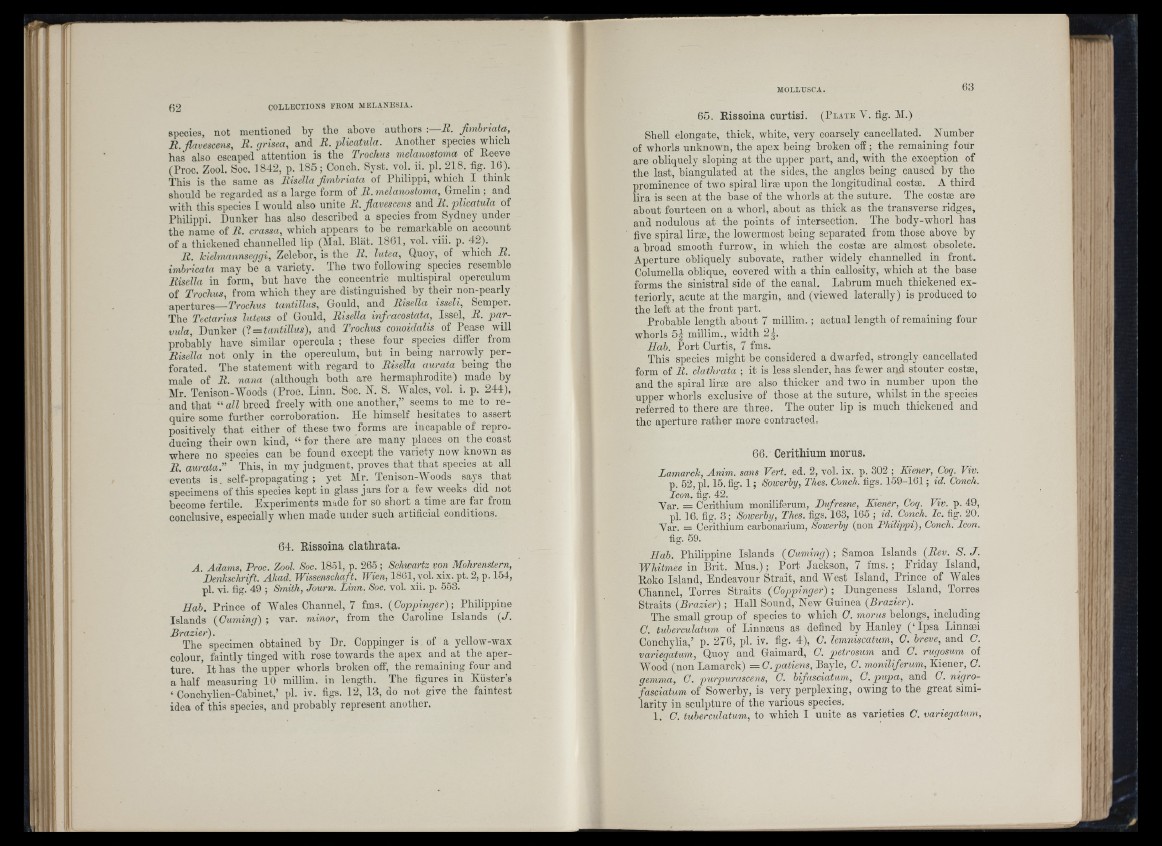
species, not mentioned by the above authors to. fimhriata,
R . flavescens, to. grisea, and to. plicatula. Another species which
has also escaped' attention is the Trochas melaxiostoma of Reeve
(Proc. Zool. Soc. 1842, p. 185; Conch. Syst. vol. ii. pi. 218. fig. 16).
This is tho same as Risella Jimbriata of Philippi, which I think
should be regarded as a large form of R.melanostoma, Cmelin ; and
with this species I would also unite to. flavescens and to. plicatula of
Philippi. Dunker has also described a species from Sydney under
the name of to. erassa, which appears to be remarkable on account
of a thickened channelled lip (Mai. Bliit. 1861, vol. viii. p. 42).
to. Icielxxiaxmseggi, Zelebor, is the to. lutea, Quojq of which to.
imbx'icata may be a variety. The two following species resemble
Risella in form, but have the concentric multispiral operculum
of Trochas, from which they are distinguished by their non-pearly
apertures— ?Voc7aw tantillus. Could, and Risella isseli. Semper.
The Tectarius luteus of Could, Risella infracostata, Issel, to. pxar-
vula, Bunker f!=taxitillus), and Troclms coxioidalis of Pease will
probably have similar opérenla ; these four species differ from
Risella not only in the operculum, but in being narrowly perforated.
The statement with regard to Risella aux-ata being the
male of to. nana (although both are hermaphrodite) made by
Mr. Tenison-AVoods (Proc. Linn. Soc. N. S. AVales, vol. i. p. 244),
and th at “ all breed freely with one another,” seems to me to require
some further corroboration. He himself hesitates to assert
positively th at either of these two forms are incapable of reproducing
their own kind, “ for there are many places on the coast
where no species can be found except the variety now known as
to. aux'ata.” This, in my judgment, proves th at th at species at all
events is. self-propagating ; yet Mr. Tenison-AVoods says that
specimens of this species kept iu glass jars for a few weeks did not
become fertile. Experiments made for so short a time are far from
conclusive, especially when made under such artificial conditions.
64. Rissoina clathrata.
A. Adams, Px-oc. Zool. Soc. 1851, p. 265; Schwax-tz von Mohrenstern,
Denhschrift. Akad. Wissenschaft. Wien, 1861, vol. xix.pt. 2, p. 154,
pi. vi. fig. 49 ; Smith, Journ. Linn. Soc. vol. xii. p. 553.
Hab. Prince of AVtoles Channel, 7 fms. {Coppinger)-, Philippine
Islands {Cuming) ; var. minor, from the Caroline Islands {J.
Braziex-).
The specimen obtained by Dr. Coppinger is of a yellow-wax
colour, faintly tinged with rose towards the apex and at the aperture.
I t has the upper whorls broken off, the remaining four and
a half measuring 10 millim. in length. The figures in Kiister’s
‘ Couchylien-Cabinet,’ pi. iv. figs. 12, 13, do not give the faintest
idea of this species, and probably represent another.
!
Î
65. Rissoina cnrtisi. (P late A', fig. M.)
Shell elongate, thick, white, very coarsely cancellated. Number
of whorls unknown, the apex being broken off ; the remaining four
are obliquely sloping at the upper part, and, with the exception of
the last, hiangulated at the sides, the angles being caused by the
prominence of two spiral liræ upon the longitudinal costæ. A third
lira is seen at the base of the whorls at the suture. The costæ are
about fourteen on a whorl, about as thick as the transverse ridges,
and nodulous at the points of intersection. The body-whorl has
five spiral liræ, the lowermost being separated from those above by
a broad smooth furrow, in w'hich tho costæ are almost obsolete.
Aperture obliquely suhovate, rather widely channelled in front.
Columella oblique, covered with a thin callosity, which at the base
forms the sinistral side of the canal. Labrum much thickened exteriorly,
acute at the margin, and (viewed laterally) is produced to
the left at the front part.
Probable length about 7 millim. ; actual length of remaining four
whorls 5^ millim., width 2^.
Hab. Port Curtis, 7 fms.
This species might be considered a dwarfed, strongly cancellated
form of to. clathx-ata ; it is less slender, has fewer and stouter costæ,
and the spiral liræ are also thicker and two in number upon the
upper whorls exclusive of those at the suture, whilst in the species
referred to there are three. The outer lip is much thickened and
the aperture rather more contracted.
66. Ceritbium morus.
Lamarck, Anim. sans Vert. ed. 2, vol. ix. p. 302 ; Kiener, Coq. Viv.
p. 52, pi. 15. fig. 1 ; Sowerhy, Thes. Conch, figs. 159-161 ; id. Conch.
Icon. tig. 42.
Var. = Cerithium moniliferum, Dufresne, Kiener, Coq. Viv. p. 49,
pi. 16. fig. 3; Sowerhy, Thes. figs. 163, 165 ; id. Conch. Ic. fig. 20.
Var. = Ceritbium carbonarium, Soiverhy (non Philiqxpi), Conch. Icon.
fig. 59.
Hah. Philippine Islands {Cuming)-, Samoa Islands {Rev. S. J.
Whitmee in Brit. Mus.) ; Port Jackson, 7 fms. ; Friday Island,
Roko Island, Endeavour Strait, and AVest Island, Prince of AVales
Channel, Torres Straits {Coppinger) ; Dungeness Island, Torres
Straits {Bi-azier) ; Hall Sound, New Cuinea {Brazier).
The small group of species to which G. morus belongs, including
C. tuberculatum of Linnæus as defined by Hanley (‘ Ipsa Linnæi
Conchylia,’ p. 276, pi. iv. fig. 4), C. lemniscatum, C. breve, and C.
variegatum, Qnoy and Gaimard, C. petx-osum and 0. rugosum of
AVood (non Lamarck) ^C .p a tie n s , Bayle, C. moniliferum, Kiener, G.
gemma, C. purpxurascens, O. bifasciatuxn, G. pupa, and G. nigro-
fasciatum of Sowerby, is very perplexing, owing to the great similarity
in sculpture of the various species.
1 . C. tuhex-culatum, to which I unite as varieties C. variegatiixn.
I
i